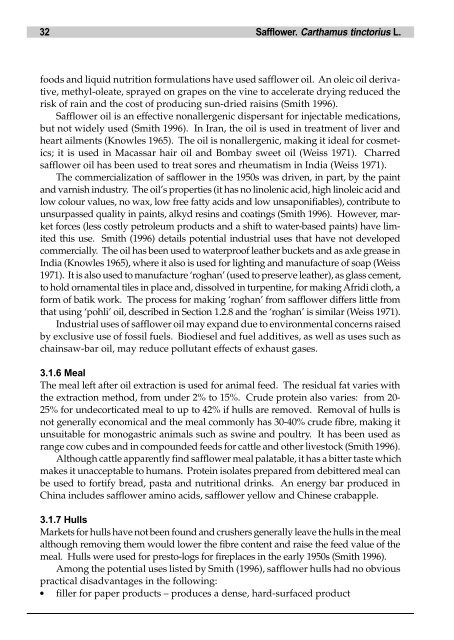Safflower, Carthamus tinctorius L. - Bioversity International
Safflower, Carthamus tinctorius L. - Bioversity International
Safflower, Carthamus tinctorius L. - Bioversity International
You also want an ePaper? Increase the reach of your titles
YUMPU automatically turns print PDFs into web optimized ePapers that Google loves.
32 <strong>Safflower</strong>. <strong>Carthamus</strong> <strong>tinctorius</strong> L.<br />
foods and liquid nutrition formulations have used safflower oil. An oleic oil derivative,<br />
methyl-oleate, sprayed on grapes on the vine to accelerate drying reduced the<br />
risk of rain and the cost of producing sun-dried raisins (Smith 1996).<br />
<strong>Safflower</strong> oil is an effective nonallergenic dispersant for injectable medications,<br />
but not widely used (Smith 1996). In Iran, the oil is used in treatment of liver and<br />
heart ailments (Knowles 1965). The oil is nonallergenic, making it ideal for cosmetics;<br />
it is used in Macassar hair oil and Bombay sweet oil (Weiss 1971). Charred<br />
safflower oil has been used to treat sores and rheumatism in India (Weiss 1971).<br />
The commercialization of safflower in the 1950s was driven, in part, by the paint<br />
and varnish industry. The oil’s properties (it has no linolenic acid, high linoleic acid and<br />
low colour values, no wax, low free fatty acids and low unsaponifiables), contribute to<br />
unsurpassed quality in paints, alkyd resins and coatings (Smith 1996). However, market<br />
forces (less costly petroleum products and a shift to water-based paints) have limited<br />
this use. Smith (1996) details potential industrial uses that have not developed<br />
commercially. The oil has been used to waterproof leather buckets and as axle grease in<br />
India (Knowles 1965), where it also is used for lighting and manufacture of soap (Weiss<br />
1971). It is also used to manufacture ‘roghan’ (used to preserve leather), as glass cement,<br />
to hold ornamental tiles in place and, dissolved in turpentine, for making Afridi cloth, a<br />
form of batik work. The process for making ‘roghan’ from safflower differs little from<br />
that using ‘pohli’ oil, described in Section 1.2.8 and the ‘roghan’ is similar (Weiss 1971).<br />
Industrial uses of safflower oil may expand due to environmental concerns raised<br />
by exclusive use of fossil fuels. Biodiesel and fuel additives, as well as uses such as<br />
chainsaw-bar oil, may reduce pollutant effects of exhaust gases.<br />
3.1.6 Meal<br />
The meal left after oil extraction is used for animal feed. The residual fat varies with<br />
the extraction method, from under 2% to 15%. Crude protein also varies: from 20-<br />
25% for undecorticated meal to up to 42% if hulls are removed. Removal of hulls is<br />
not generally economical and the meal commonly has 30-40% crude fibre, making it<br />
unsuitable for monogastric animals such as swine and poultry. It has been used as<br />
range cow cubes and in compounded feeds for cattle and other livestock (Smith 1996).<br />
Although cattle apparently find safflower meal palatable, it has a bitter taste which<br />
makes it unacceptable to humans. Protein isolates prepared from debittered meal can<br />
be used to fortify bread, pasta and nutritional drinks. An energy bar produced in<br />
China includes safflower amino acids, safflower yellow and Chinese crabapple.<br />
3.1.7 Hulls<br />
Markets for hulls have not been found and crushers generally leave the hulls in the meal<br />
although removing them would lower the fibre content and raise the feed value of the<br />
meal. Hulls were used for presto-logs for fireplaces in the early 1950s (Smith 1996).<br />
Among the potential uses listed by Smith (1996), safflower hulls had no obvious<br />
practical disadvantages in the following:<br />
● filler for paper products – produces a dense, hard-surfaced product

















